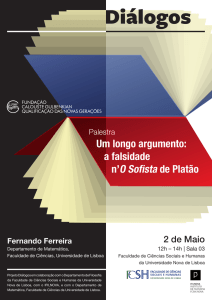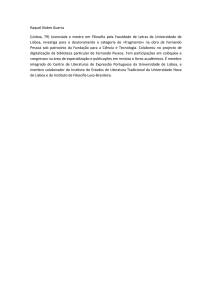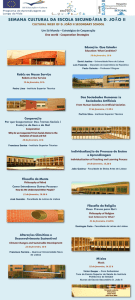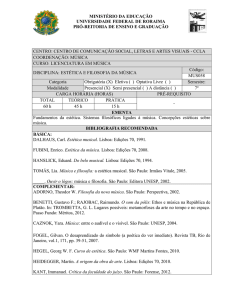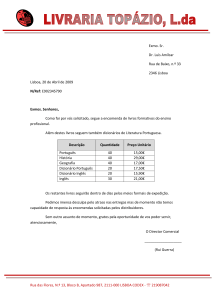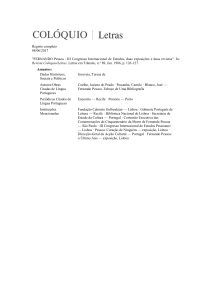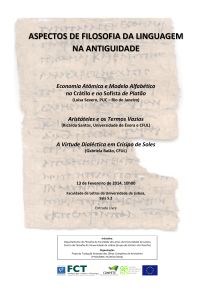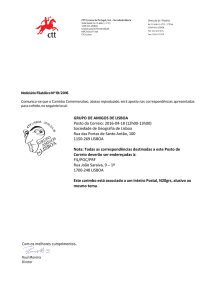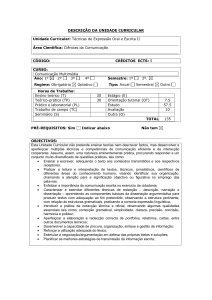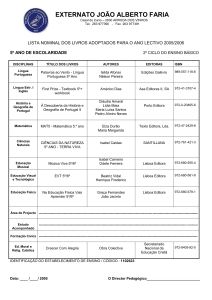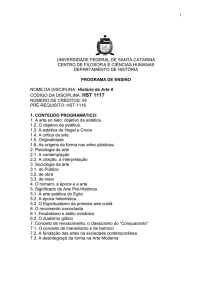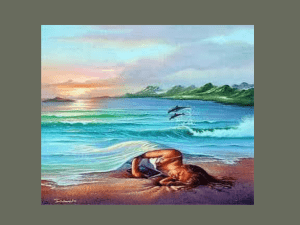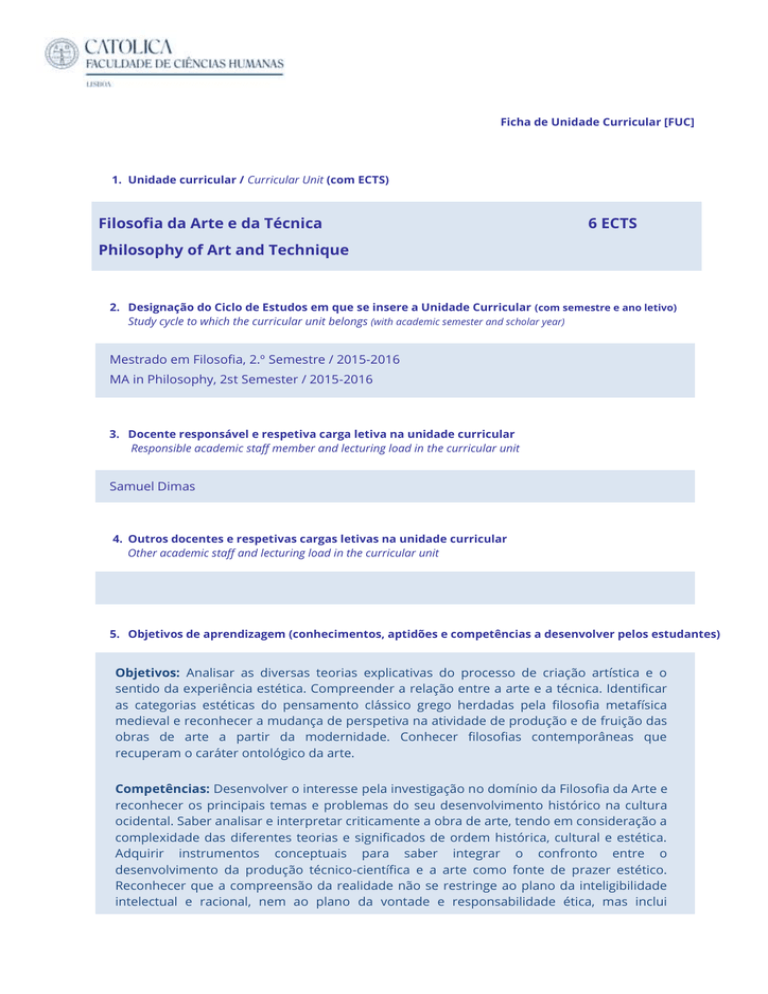
Ficha de Unidade Curricular [FUC]
1. Unidade curricular / Curricular Unit (com ECTS)
Filosofia da Arte e da Técnica
6 ECTS
Philosophy of Art and Technique
2. Designação do Ciclo de Estudos em que se insere a Unidade Curricular (com semestre e ano letivo)
Study cycle to which the curricular unit belongs (with academic semester and scholar year)
Mestrado em Filosofia, 2.º Semestre / 2015-2016
MA in Philosophy, 2st Semester / 2015-2016
3. Docente responsável e respetiva carga letiva na unidade curricular
Responsible academic staff member and lecturing load in the curricular unit
Samuel Dimas
4. Outros docentes e respetivas cargas letivas na unidade curricular
Other academic staff and lecturing load in the curricular unit
5. Objetivos de aprendizagem (conhecimentos, aptidões e competências a desenvolver pelos estudantes)
Objetivos: Analisar as diversas teorias explicativas do processo de criação artística e o
sentido da experiência estética. Compreender a relação entre a arte e a técnica. Identificar
as categorias estéticas do pensamento clássico grego herdadas pela filosofia metafísica
medieval e reconhecer a mudança de perspetiva na atividade de produção e de fruição das
obras de arte a partir da modernidade. Conhecer filosofias contemporâneas que
recuperam o caráter ontológico da arte.
Competências: Desenvolver o interesse pela investigação no domínio da Filosofia da Arte e
reconhecer os principais temas e problemas do seu desenvolvimento histórico na cultura
ocidental. Saber analisar e interpretar criticamente a obra de arte, tendo em consideração a
complexidade das diferentes teorias e significados de ordem histórica, cultural e estética.
Adquirir instrumentos conceptuais para saber integrar o confronto entre o
desenvolvimento da produção técnico-científica e a arte como fonte de prazer estético.
Reconhecer que a compreensão da realidade não se restringe ao plano da inteligibilidade
intelectual e racional, nem ao plano da vontade e responsabilidade ética, mas inclui
também o plano do sentimento da beleza e da harmonia, manifesto na experiência
estética.
Learning outcomes of the curricular unit
Objectives: Analysing the diverse theories explaining the processes of artistic creation and
the meaning of aesthetic experiences. Grasping the relationship between art and
technique. Identifying the aesthetic categories of classical Greek thinking inherited by
medieval metaphysical philosophy and recognising the changes in perspectives regarding
the activities surrounding the production and appreciation of works of art within the
context of modernity. Understanding how contemporary philosophies have restored the
ontological character of art.
Competences: Developing research interests in the field of the Philosophy of Art and
recognising the main themes and problems related to its historical development within
western culture. Knowing how to critically analyse and interpret works of art taking into
consideration the complexity of the different theories and meanings in historical, cultural
and aesthetic terms. Acquiring the conceptual instruments necessary to integrating the
confrontation between the development of technical-scientific and artistic production as a
source of aesthetic pleasure. This recognises how the grasping of reality extends beyond
not only the level of intellectual and rational intelligibility but also that of ethical will and
responsibility whilst also including the scope of sense of beauty and harmony as manifest
in the aesthetic experience.
6. Conteúdos programáticos
1.
Filosofia da Arte e da Técnica
1.1. A arte como imitação, representação, expressão e forma
1.2. A arte e a experiência estética; a ontologia da arte e o sentimento da beleza
1.3. A arte e a técnica; a arte e a moral; a arte e a religião
2.
A mimesis do belo ideal e da natureza na Antiguidade Clássica
2.1. Técnica, imitação e beleza metafísica em Platão
2.2. Técnica, cosmologia, poética e retórica em Aristóteles
2.3. O belo como participação da forma da Unidade divina em Plotino
3.
A beleza transcendental na Época Medieval
3.1. A arte como conhecimento e como técnica em Santo Agostinho
3.2. A beleza da criação e da revelação como itinerário para Deus em São Boaventura
3.3. A beleza, verdade e bondade em São Tomás de Aquino
4.
A revalorização do sentimento e da imaginação na arte da Modernidade: do
Renascimento ao Neo-classicismo das Luzes e ao Romantismo do séc. XIX
4.1. Arte e técnica em Alberti e Leonardo Da Vinci e Miguel Ângelo
4.2. Revalorização do sentimento em Baumgarten
4.3. As condições formais do juízo estético; o gosto, o belo e o sublime em Kant
4.4. O sentimento e a religiosidade na estética panteísta de Schelling
4.5. A arte como expressão fenomenológica do Espírito na teoria da história de Hegel
5.
O progresso técnico-científico e a metafísica da arte na Contemporaneidade
5.1. Arte e técnica em Heidegger
5.2. A «visão do invisível» e a «essência da arte» em Michel Henry
5.3. A «forma significante» e a «hipótese metafisica» em Clive Bell
5.4. O alcance metafísico da «arte pura» e da «intuição estética» em Louis Lavelle
5.5. A beleza como expressão transcendental da realidade em Xavier Zubiri
Syllabus
6.
Philosophy of Art and Technique
6.1. Art as imitation, representation, expression and form
6.2. Art and aesthetic experiences; the ontology of art and the feeling of beauty
6.3. .Art and technique; art and morality; art and religion
7.
The mimesis of ideal beauty and nature in Classical Antiquity
7.1. Technique, imitation and metaphysical beauty in Plato
7.2. Technique, cosmology, poetics and rhetoric in Aristotle
7.3. Beauty as a means of participating in the form of divine unity in Plotinus
8.
Transcendental beauty in the Medieval period
8.1. Art as knowledge and technique in Saint Augustine
8.2. The beauty of creation and revelation as a pathway towards God in Saint
Bonaventure
8.3. Beauty, truth and will in Saint Thomas Aquinas
9.
The revaluation of sentiment and imagination in the art of Modernity: from the
Renaissance to the Neo-classicism of the Enlightenment and to the Romanticism
th
of the 19 century
9.1. Art and technique in Alberti and Leonardo Da Vinci and Michelangelo
9.2. Revaluing sentiment in Baumgarten
9.3. The formal terms for aesthetic judgement; taste, beauty and the sublime in Kant
9.4. Sentiment and religiosity in the pantheist aesthetic of Schelling
9.5. Art as a phenomenological expression of the Spirit in Hegel’s theory of history
10. Technical-scientific progress and metaphysical art in contemporary times
10.1. Art and technique in Heidegger
10.2. The «vision of the invisible» and the «essence of art» in Michel Henry
10.3. The «significant form» and «metaphysical hypotheses» in Clive Bell
10.4. The metaphysical reach of «pure art» and «aesthetic intuition» in Louis Lavelle
10.5. Beauty as a transcendental expression of reality in Xavier Zubiri
7. Metodologia de ensino (avaliação incluída)
Ensino: Ensino Presencial. Metodologia de Avaliação Contínua
Avaliação: São elementos de avaliação: 1) Trabalho sobre um autor ou tema (60% da
avaliação); 2) protocolos (20% da avaliação); 3) prova de oralidade: defesa do trabalho (20%
da avaliação).
Teaching methodologies (including evaluation)
Teaching: In person attendance. Continuous evaluation methodology
Evaluation: Factors subject to evaluation: 1) Extended essay on an author or a theme (60%
of total evaluation); 2) protocols (20%); 3) viva voce defence of the essay (20%).
8. Bibliografia principal
Main bibliography
ADORNO, Theodor W., Teoria estética, trad de Artur Morão, Lisboa, Edições 70, 2008;
AFONSO, Filipa, Figuras da Luz. Uma leitura estética da metafísica de São Boaventura,
Lisboa, Centro de Filosofia da Universidade de Lisboa, 2015;
ARISTÓTELES, Poética, trad. de Eudoro de Sousa, Lisboa, INCM, 1990;
BAUMGARTEN, A. G., Esthétique, éd. de l’Herne, 1988;
BAYER, Raymond, História da Estética, trad. de José Saramago, Lisboa, Editorial Estampa,
1995;
BENJAMIN, Walter, «A obra de arte na era da sua reprodutibilidade técnica», in Sobre arte,
técnica, linguagem e política, trad. de Maria Luz Moita, Lisboa, Relógio d´Água, 1992;
BORGES-DUARTE, Irene, Arte e Técnica em Heidegger, Lisboa, Documenta, 2014;
CARROLL, Noël, Filosofia da arte, Lisboa, Ed. Texto & Grafia, 2010;
DIMAS, Samuel, Regresso ao Paraíso: Estudos sobre a redenção do Mundo, Lisboa,
UCEditora, 2014;
ECO, Umberto, Arte e beleza na Estética Medieval, Lisboa, Ed. Presença, 1989;
FERREIRA, Ana Rita, Do Escondido. Santo Agostinho e os limites da Estética, Paris, Nota de
Rodapé Edições, 2015;
FRANCASTEL, P., Arte e Técnica nos séc. XIX e XX, Lisboa, Livros do Brasil, 2000;
HEGEL, G.W.F., Estética, trad. de Álvaro Ribeiro e Orlando Vitorino, Lisboa, Guimarães
Editores, 1993;
HEIDEGGER, M., «A questão da técnica», in Ensaios e Conferências, Petrópolis, Ed. Vozes,
2002; idem, Caminhos de floresta, Lisboa, Fundação Calouste Gulbenkian, 2002;
JONAS, Hans, Tecnica, medicina y ética, Barcelona, Paidos,1997;
LACOSTE, Jean, A Filosofia da Arte, trad. de Álvaro Cabral, Rio de Janeiro, Jorge Zahar Editor,
1986;
KANT, Immanuel, Crítica da faculdade de julgar, Lisboa, INCM, 1998; idem, Observações
sobre o sentiment do belo e do sublime, trad. de Pedro Panarra, Lisboa, Edições 70, 2012;
KIVY, Peter, (org.), Estética: Fundamentos e questões de Filosofia da Arte, São Paulo, Paulus,
2008;
LOUSA, Teresa, Do Pintor como Génio na obra de Francisco de Holanda, Lisboa, Editora Sítio
do Livro, 2014;
TOWNSEND, Dabney, Introdução à estética: História: Correntes: Teorias, Lisboa, Edições 70,
2002.

